The psoas muscle, a deep core stabilizer, plays a crucial role in hip flexion and posture. Stretching it improves flexibility, reduces lower back pain, and enhances movement. This guide provides essential stretches and techniques to target the psoas effectively.
Understanding the Psoas Muscle and Its Importance
The psoas muscle, a deep core stabilizer, runs from the lower back to the femur, playing a vital role in hip flexion, posture, and movement. It is essential for activities like walking, running, and maintaining proper spinal alignment. Tightness or imbalance in the psoas can lead to lower back pain and limited mobility, making stretching and strengthening crucial for overall musculoskeletal health and functionality.
Why Stretching the Psoas is Essential for Flexibility and Pain Relief
Stretching the psoas is vital for maintaining flexibility and alleviating muscle tension. Tight psoas muscles can lead to lower back pain, poor posture, and limited mobility. Regular stretching enhances hip flexion, improves posture, and reduces discomfort. It also promotes better movement patterns, reducing the risk of injury and enhancing overall athletic performance. Addressing psoas tightness can significantly improve quality of life and physical functionality.
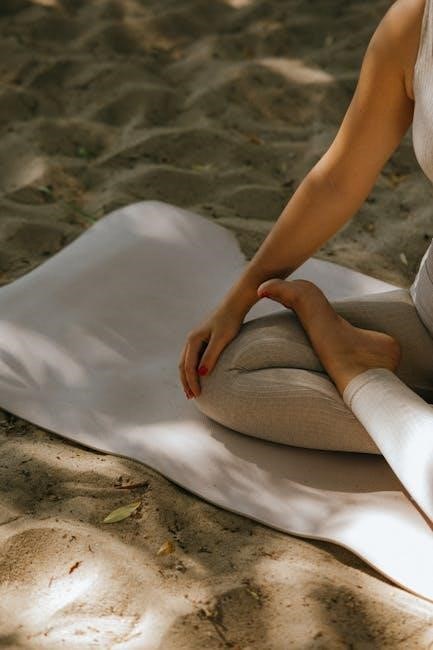
Key Psoas Stretches for Beginners
Begin with kneeling hip flexor and supine psoas stretches to gently release tension, improve flexibility, and enhance mobility in the hip and lower back area.
Kneeling Hip Flexor Stretch: Step-by-Step Guide
Start by kneeling on one knee, with the other foot flat on the floor in front of you. Ensure your hips are square and your front knee aligns with your ankle. Gently push your hips forward until you feel a stretch in the front of your hip and thigh. Keep your chest upright and engage your core for stability. Hold the stretch for 20-30 seconds, then switch sides. Repeat 2-3 times for optimal relief.
Supine Psoas Stretch: Targeting the Iliopsoas Muscle
Lie on your back with knees bent and feet flat on the floor. Pull one knee toward your chest, holding onto your shin for support. Allow the opposite leg to hang freely off the edge of a bed or table. Keep your lower back pressed into the floor and hold the stretch for 30 seconds to release the iliopsoas muscle. Repeat on the other side for balanced relief and improved hip flexibility.
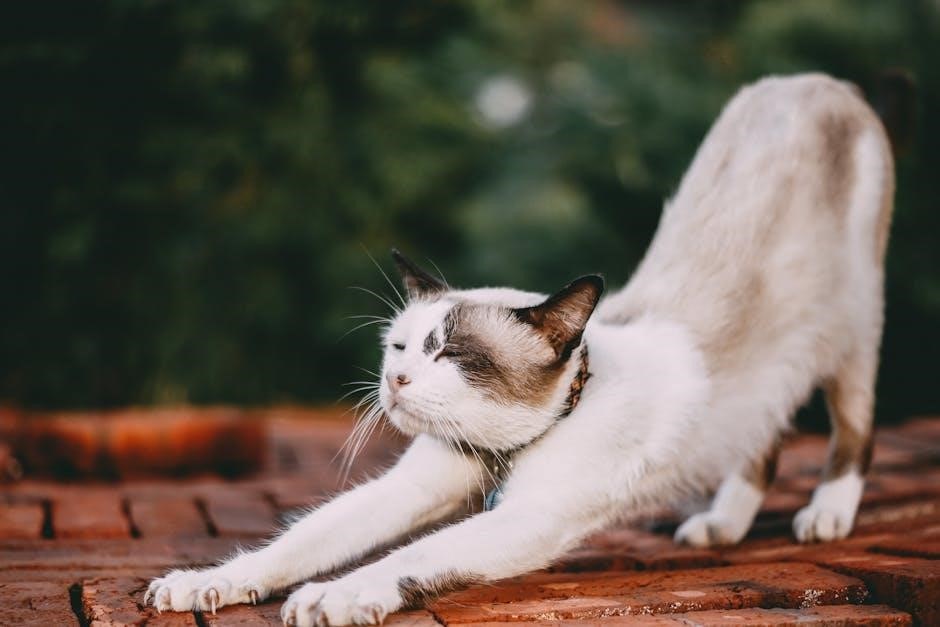
Advanced Psoas Stretching Techniques
Bridge stretches and lunge variations target the psoas muscle, enhancing flexibility and strength. These techniques require controlled movements and proper form to maximize effectiveness and prevent injury.
Bridge Psoas Stretch: Enhancing Hip Flexibility
The bridge psoas stretch targets the iliopsoas muscle, improving hip flexibility. Lie on your back with knees bent and feet flat. Engage your core, lift hips, and squeeze glutes. Hold for 10-15 breaths, ensuring controlled movements. This stretch strengthens the lower back and pelvis, enhancing posture and reducing muscle tension. Regular practice promotes better hip mobility and overall flexibility.
Lunge Stretch Variations for Deep Psoas Release
The lunge stretch targets the psoas muscle, enhancing flexibility and relieving tension. Begin in a kneeling lunge position, with your front knee at 90 degrees. Slowly extend the back leg, keeping the spine aligned, until a stretch is felt in the front of the hip. Hold for 3 deep breaths, then add side stretches or twists for deeper release. This variation improves hip mobility and reduces lower back strain, promoting overall muscle balance.
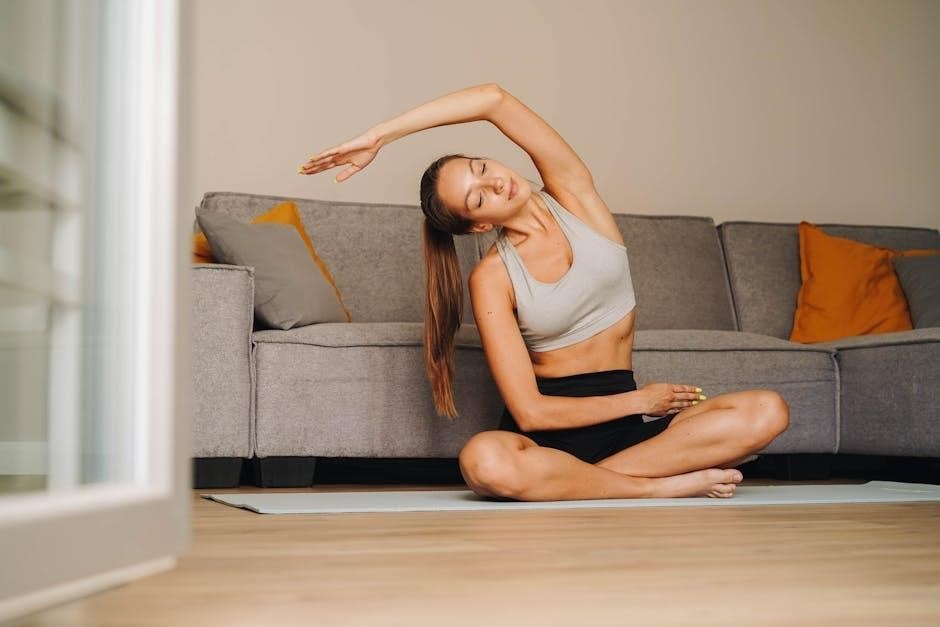
Yoga Poses for Psoas Release
Yoga offers effective poses like Anjaneyasana (Low Lunge) and Eka Pada Rajakapotasana (Pigeon Pose) to release the psoas muscle. These poses improve flexibility, reduce hip tension, and enhance overall mobility, providing relief from tightness and discomfort.
Anjaneyasana (Low Lunge Pose) for Hip Flexor Opening
Anjaneyasana, or Low Lunge Pose, is a powerful yoga stretch for the hip flexors and psoas muscle. To perform, step one foot forward into a lunge, keeping the back knee nearly touching the ground. Lower your torso slightly, stretching the front of your hip and thigh. Engage your core, keep your chest upright, and hold for 3-5 deep breaths. This pose enhances flexibility, reduces tension, and promotes relaxation in the lower back and hips.
Eka Pada Rajakapotasana (Pigeon Pose) for Targeted Stretch
Eka Pada Rajakapotasana, or Pigeon Pose, offers a deep stretch for the psoas and hip flexors. Kneel with one leg extended behind and the other bent in front. Lower your torso, stretching the back hip and thigh. Use props like a block or cushion for comfort. Hold for 3-5 breaths, then switch sides. This pose improves hip flexibility, reduces muscle tension, and enhances posture by targeting the iliopsoas and surrounding tissues effectively.

Safety Tips and Precautions
Always warm up before stretching to prevent muscle strain. Avoid bouncing or forcing stretches beyond mild discomfort. Focus on controlled movements and proper breathing techniques to ensure safety and effectiveness during psoas stretching exercises.
Avoiding Overstretching and Preventing Injury
Avoiding overstretching is crucial to prevent injury. Start with gentle stretches and gradually increase intensity. Stop if pain occurs. Focus on controlled movements, avoiding bouncing. Proper form ensures targeting the correct muscles without strain. Breathing deeply helps relax the muscle. Overstretching can lead to microtears or inflammation, so listen to your body and modify stretches as needed. Consistency and patience yield better results than aggressive stretching.
Modifications for Different Fitness Levels
Modify stretches based on fitness levels. Beginners can use support, like a yoga block, to reduce intensity. Intermediate practitioners can deepen stretches by leaning further forward. Advanced individuals may incorporate dynamic movements or balance challenges. For those with mobility issues, seated or supine stretches are effective alternatives. Adjustments ensure safety and effectiveness, making psoas stretching accessible to everyone while promoting progress without risking injury.

Frequency and Duration of Psoas Stretching
Stretch 2-3 times weekly, holding each pose for 20-30 seconds. Daily routines of 10-15 minutes can enhance flexibility and relief. Consistency is key for optimal results.
How Often to Stretch for Maximum Benefits
For optimal benefits, stretch the psoas 2-3 times weekly, with each session lasting 10-15 minutes. Daily stretching can enhance flexibility but may overstrain. Consistency is key; incorporating stretches like the kneeling hip flexor or bridge pose into your routine ensures gradual improvement. Overstretching should be avoided to prevent injury, maintaining a balance between flexibility and muscle strength for overall well-being and pain relief.
Optimal Hold Times for Each Stretch
Hold each psoas stretch for 20-30 seconds to allow the muscle to relax and lengthen. For deeper release, extend holds up to 90 seconds, focusing on deep, controlled breaths. Avoid bouncing or forcing beyond discomfort. Gentle, sustained pressure enhances flexibility and reduces muscle tension, promoting effective relief and improving range of motion over time with consistent practice.
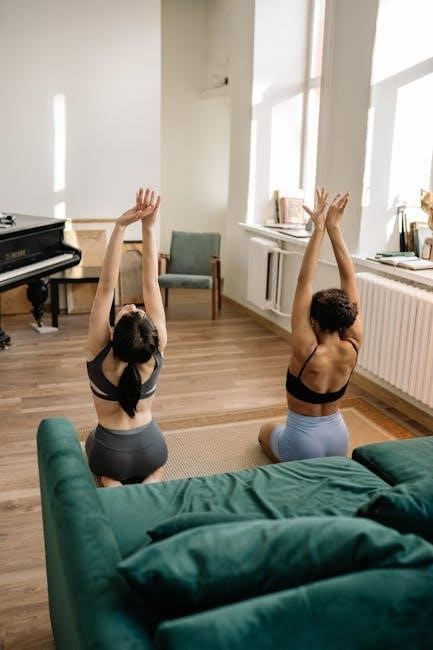
Combining Psoas Stretches with Other Exercises
Combine psoas stretches with yoga poses, core exercises, and breathing techniques for a holistic approach. This enhances balance, posture, and overall flexibility while preventing muscle imbalances.
Incorporating Strengthening Exercises for Balance
Strengthening the core and glutes is essential for balancing psoas stretches. Exercises like planks, bird dogs, and glute bridges enhance stability and prevent muscle imbalances. These movements support proper posture, reduce injury risk, and improve overall athletic performance. Pairing strength training with stretching ensures a balanced approach to psoas health, promoting long-term flexibility and strength.
Pairing with Lower Back Stretches for Full-Body Flexibility
Combining psoas stretches with lower back exercises enhances overall flexibility and reduces muscle tension. Stretches like cat-cow, child’s pose, and spinal twists complement psoas work by relieving tightness in the lower back. This integrated approach promotes better posture, reduces discomfort, and improves mobility. By addressing both the psoas and lower back, you achieve a more balanced and effective stretching routine for full-body flexibility and relaxation.

Creating a Daily Psoas Stretching Routine
A consistent routine boosts flexibility and reduces muscle tension. Start with simple stretches like the kneeling hip flexor or cat-cow pose, gradually increasing intensity. Aim for 10-15 minutes daily to maintain progress and prevent stiffness.
Sample 10-15 Minute Routine for Consistency
Start with a 2-minute warm-up, such as light walking or pelvic tilts. Perform the kneeling hip flexor stretch for 30 seconds per side. Follow with the supine psoas stretch, holding for 20-30 seconds. Include the bridge stretch to enhance hip flexibility. Conclude with gentle cat-cow stretches and deep breathing exercises. Repeat the sequence 2-3 times, ensuring smooth transitions between stretches. End with a 2-minute cool-down to relax the muscles and improve circulation.
Tracking Progress and Adjusting as Needed
Track your progress by noting improvements in flexibility, reduced muscle tension, and ease of movement. Adjust your routine based on discomfort or advancements in flexibility. Increase hold times or depth gradually. Incorporate strengthening exercises to balance flexibility. Maintain a consistent schedule and modify stretches as needed. Use a log or app to monitor progress and ensure you’re meeting your goals. Adjustments keep the routine effective and prevent plateaus.
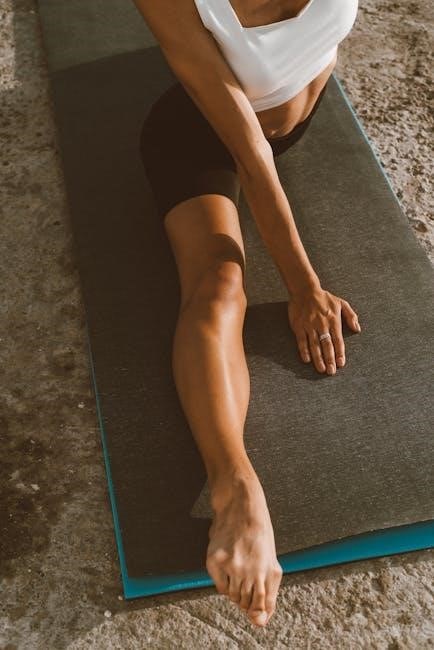
Common Mistakes to Avoid in Psoas Stretching
Avoid overstretching, which can cause injury. Ensure proper form and breathing techniques. Ignoring signs of strain or discomfort can lead to muscle imbalances or further tightness.
Overlooking Proper Form and Breathing Techniques
Proper form and breathing are crucial for effective and safe psoas stretching. Neglecting to maintain correct posture or breathe deeply can reduce the stretch’s effectiveness and increase injury risk. Many individuals lean too far forward or arch their back, which can strain the lower back instead of targeting the psoas. Consistent practice with mindful breathing ensures a safe and beneficial stretch, enhancing flexibility and relieving tension in the hip flexors and psoas muscle.
Ignoring Signs of Strain or Discomfort
Ignoring signs of strain or discomfort during psoas stretching can lead to muscle imbalances or injuries. Tight hip flexors and psoas tension often cause lower back discomfort, but pushing through pain can worsen inflammation. It’s vital to listen to your body and adjust stretches to avoid overextension. Proper form and gradual progression are key to safely releasing psoas tightness without risking long-term damage or chronic pain.
Regular psoas stretching enhances flexibility, reduces pain, and promotes overall well-being. By incorporating these exercises into your routine, you can maintain a healthy, balanced musculoskeletal system and improve mobility.
Final Thoughts on the Importance of Psoas Stretching
Regular psoas stretching is vital for maintaining flexibility, reducing chronic pain, and improving posture. It enhances athletic performance and prevents injuries by ensuring optimal hip and lower back mobility; Incorporating psoas stretches into daily routines can significantly boost overall musculoskeletal health and well-being.
Encouragement to Maintain a Regular Stretching Practice
Consistency is key to experiencing the benefits of psoas stretching. By dedicating just a few minutes daily, you can improve flexibility, reduce muscle tension, and enhance overall mobility. Incorporate stretches into your routine, track progress, and celebrate small victories. Over time, this practice will become a cornerstone of your wellness journey, promoting long-term physical and mental well-being.





